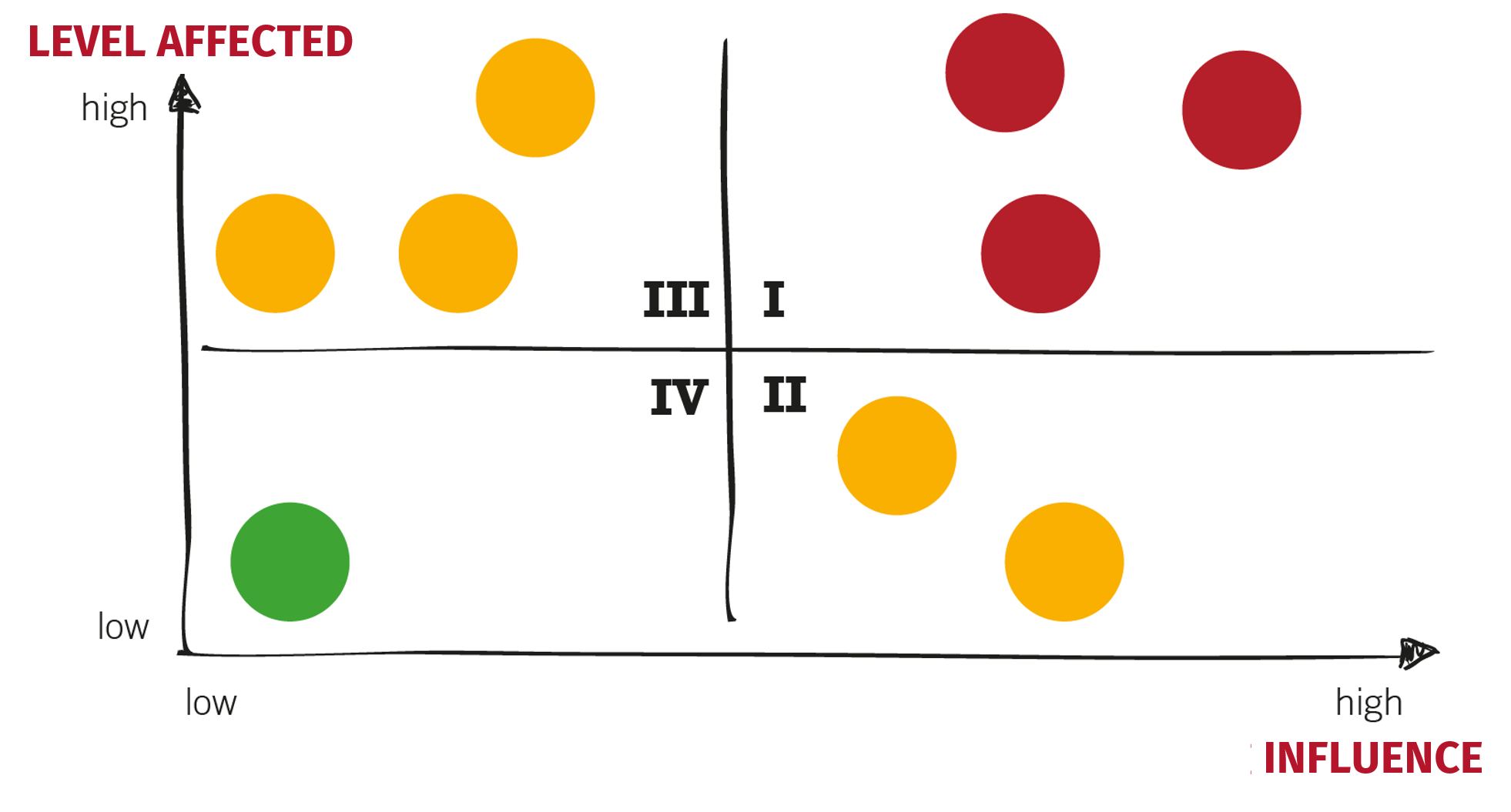STAKEHOLDERS¶
Who is affected by the project?¶
Stakeholders are affected by a project or can exert influence on it [12].
They can have a positive, negative or neutral attitude. It is important to gain an impression of the stakeholders in order to adapt to their reactions if necessary. The stakeholder strategy addresses the stakeholders in the project and involves them in the design of the future product. Both Scrum Masters and Product Owners should think about their stakeholders. What are examples of stakeholders from the perspective of the Product Owner and Scrum Master?
From the perspective of the Product Owner: Customer, client, users, developers in the team, sales and marketing, suppliers, etc.
From the Scrum Master's perspective: All persons or units involved in the Scrum project, company environment, board area, supervisors of the development team, line organisation, HR department, procurement, works councils, etc.
The following steps must be carried out:
- Analyse the various stakeholders or stakeholder groups based on their influence and how they are affected.
- Develop a strategy on how to deal with the stakeholders in the project (information via portal or newsletter, formation of a core team, personal contact, invitation to Sprint Reviews).
- Carry out stakeholder analyses on a rolling basis as required and check for any changes, especially after important events (e.g. sprint, backlog refinement meeting, etc.).
Stakeholder analysis chart¶

Depending on the arrangement of the stakeholders in the various quadrants, the organisational connection to the project and stakeholder communication must be clarified [13].
Stakeholder and project environment management¶
There are various measures to choose from, but the Product Owner and Scrum Master are subject to the creative leeway in dealing with the project environment and the stakeholders. Possible measures (depending on the size of the agile project) can be:
Quadrant 1:
These are the stakeholders who derive a significant benefit from the product and have a major influence on its design. These could be customers, major investors or extremely important users, for example. These stakeholders are the supporters of the project and should therefore be involved - preferably by inviting them to Sprint Reviews and Backlog Refinement Meetings or through other regular meetings to identify needs.
Quadrant 2:
This is where people who have a significant influence on the project but are not significantly interested in its success are categorised. This could be a department manager, for example, who does not invest their own budget in the development and to whom the Scrum Team must report. Or a software architect whose technical decisions must be followed by the team. Important customers of your company are also in this quadrant. Although these stakeholders have no direct interest in the product, they should still be satisfied and may become supporters in the course of the project.
Quadrant 3:
Stakeholders who are very interested in the success of the project, but have only a moderate or small influence on it, are listed here. These could be frequent users of the product, or people who have made smaller investments (e.g. through crowdfunding). As these stakeholders are the future users of the product, it makes sense to invite a selection of them to the Sprint Review. Other ways of involving them in the project could be in the form of videos or newsletters reporting on the progress of the project. They can also be asked for feedback through online surveys. They will certainly be happy to support the project.
Quadrant 4
Here you will find stakeholders who have no interest in or influence on your project. Therefore, it is often sufficient to inform this group when necessary. For example, in the form of a press release or an article on the company website. It may be possible to "recruit" stakeholders from this quadrant by actively involving them or by taking advantage of their needs.
CAUTION: The distribution of stakeholders is, in any case, only a snapshot - it is quite possible that the stakeholders will shift to other quadrants in the course of the project.
Further options for the Product Owner and the Scrum Master for integration¶
Product Owner:
Participation in the Sprint Planning Meetings and Sprint Reviews, formation of an external working group, continuous information through info letters or formation of a project portal.
Scrum Master:
Networking within the company, personal contact with key people in the company, formation of a working group to establish Scrum, creation of an info portal, development of the necessary steps together with managers.